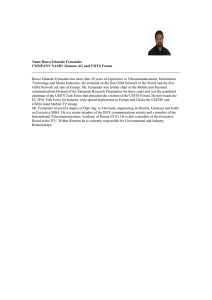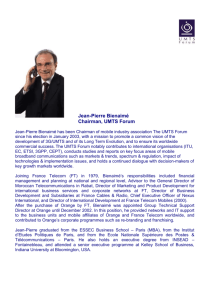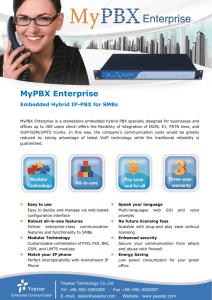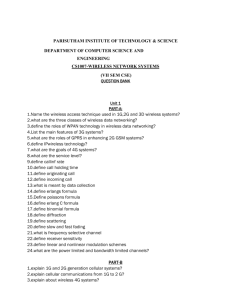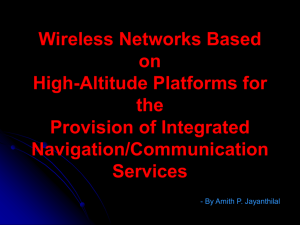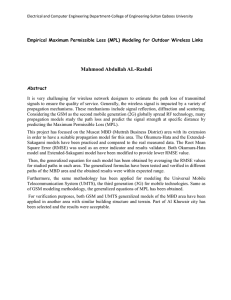UMTS/IMT2000 IN PORTUGAL BACKGROUND, COMPETITION
advertisement
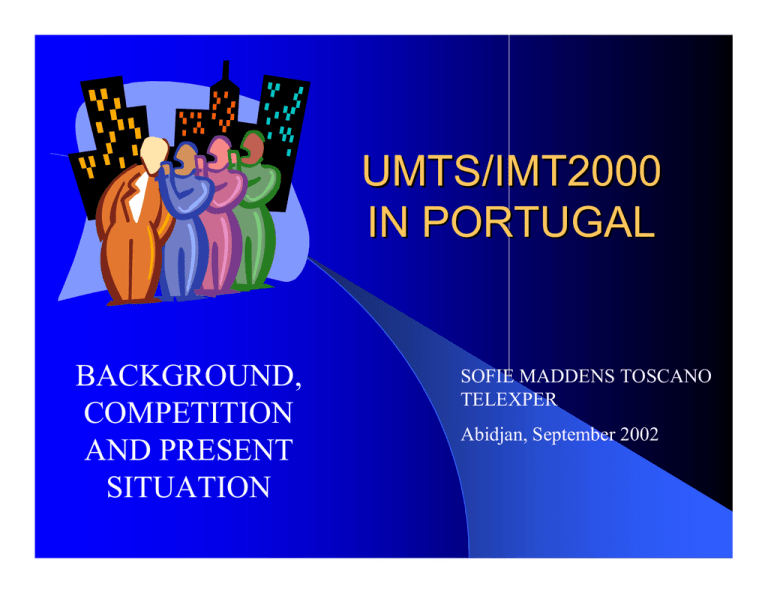
UMTS/IMT2000 IN PORTUGAL BACKGROUND, COMPETITION AND PRESENT SITUATION SOFIE MADDENS TOSCANO TELEXPER Abidjan, September 2002 BACKGROUND Chronology of Mobile Communications in Portugal !1989 - Launch of Land Mobile Service, using analogue technology by a consortium between CTT and TLP (incumbents) – renamed TMN !1991 - Public Tender for the assignment of a license to operate second generation technology - GSM - in the 900 MHz band: 8 bids submitted to tender – Telecel ( consortium consisting of Pacific Telesis, Amorim Group, Banco Espirito Santo, etc.) !1992 - Launch of activity of 2nd mobile operator - Telecel and start of operations of TMN’s GSM network (TMN was automatically assigned a GSM license) Chronology of Mobile Communications in Portugal !1997 - Public Tender for the assignment of a license to operate 2nd generation technology – GSM and DCS 1800 – 1 bid submitted to public tender and only tenderer – Optimus (consortium consisting of Sonae Group, France Telecom, EDP, IPE, Maxitel, …) – granted license. Assignment of DCS 1800 frequencies to the mobile operators present in the market – TMN and Telecel !1998 – Launch of activity of third mobile operator – Optimus !April 1999 – Public Consultation to receive statements of interest on the provision of services and/or constitution of networks within the framework of UMTS Chronology of Mobile Communications in Portugal !August 1, 2000 - Launch of Public Tender for UMTS/IMT 2000 !December 19, 2000 - Announcement by Minister of winners of the public tender !January licenses 11, 2001 - Issue of UMTS/IMT 2000 Chronology of Mobile Communications in Portugal !October, 2001 - Launch of UMTS/IMT 2000 postponed to December 31, 2002 !January 1, 2002 - Introduction of number portability in the mobile network !December 31, 2002 – Start of activity of UMTS/IMT2000 operators foreseen (DELAYED, POSSIBLY EVEN UNTIL JANUARY 2004…) Evolution of the Telecommunications Sector in Portugal Year Fixed Telephony 1991 1992 1993 1994 1995 1996 1997 1998 1999 2000 2001 2002 (1Q) 2,694 3,014 3,260 3,444 3,643 3,822 4,002 4,117 4,230 4,314 4,378 4,368 Values in thousands Land Mobile Telephony 12.6 37.3 101.2 173.5 304.8 663.7 1,507.0 3,074.6 4,671.5 6,665.0 7,977.5 8,071.3 Cable TV Service Internet Access 58.0 171.0 383.0 596.0 760.0 925.0 1,119.0 1,158.0 2.0 12.0 46.0 88.7 172.7 474.4 2,110.8 3,459.4 3,912.2 Evolution of the Telecoms Sector in Portugal 5193,5 Mobile phones > 5 million For the first time the number of mobile subscribers > 5mio, meaning that more than half of the Portuguese population has a mobile phone. Short calls – how the Portuguese use their mobile phones 4671,5 Number of calls per day 3 3074,6 Constantly growing – Evolution of the number of subscribers of mobile phones ( in thousands) 2,8 6,5 12,6 37,3 101,2 173,5 1507 340,8 Average duration of each call Total mobile traffic 91 (2001) 663,7 2001 In seconds 10.967,0 1st quarter / 2002 3.047,2 ‘000 of million of minutes % of Portuguese > 15 yrs old with mobile phone 1989 1990 1991 1992 1993 1994 1995 1996 1997 1998 1999 2000 62,5% Evolution of the Telecommunications Sector in Portugal – Mobile 1998 2001/... TMN (C-450: 1989 GSM:1992) TELECEL (GSM:1992) OPTIMUS (September 1998) National/Local Operators DCS 1800 UMTS Operators C-450 still exists Closure of C-450 Growth of market share of mobile telephony as compared to fixed telephony Fixed-mobile convergence WAP Growth of market share for data, fax, financial services and internet Traffic towards DECT and LEO´s GSM technology GSM/DCS 1800 technology Better coverage (micro e pico); half/fullrate techniques Evolution of the Telecommunications Sector in Portugal •Number of subscribers •Penetration Rate • Var. 01/00 Annual growth rate. • Penetration Rate in Europe on 30/03/2002 1992 1st quarter 2002 37 262 8 071 300 0% 77,9% 19,7% 75,6% Evolution of the Telecommunications Sector – Fixed Telephony 2001/... 1998 Portugal Telecom Novis Jazztel Portugal Telecom Global One Oni Teleweb Maxitel Interoute TMN Operadores Globais Operadores deTVCabo Operator pre-selection Introduction of competition in Portugal through mobile telephony Competition in international traffic: call back, resellers, ... Indirect access to all traffic Direct Access FWA ULL “competes” with harmonisation of prices and the introduction of global operators Evolution of the Telecommunications Sector in Portugal •Nº OF LICENSED SERVICE PROVIDERS •Nº OF LICENSED SERVICE PROVIDERS IN ACTIVITY • Nº OF MAIN LINES (IN THOUSANDS) 2000 2001 1st Q 2002 24 28 28 14 15 15 4.313,6 4.377,7 4.367,6 43,1% 42,3 42,2% 14.606 15..255 3.710 •PENETRATION RATE • NATIONAL TRAFFIC (MILLIONS OF MINUTES) Evolution of the Telecommunications Sector in Portugal 1997 2001 1ºQ2002 •Number of Internet Subscribers 88 670 3459433 3912207 •Penetration Rate 0,9% 33,4% 37,8% •Number of Domains 1 981 18 895 19 711 •Number of POP´s 288 476 501 •Number of Registered Providers 10 48 53 •Number of Active Providers 8 30 29 Evolution of the Telecommunications Sector in Portugal 1997 2001 6 8 8 •# Dedicated Accesses 17 929 21493 21271 •# Switched Accesses 5506 5457 5474 • Total Traffic (Mb) 2 773052 47349454 12432415 8 11 11 1925 13898 15122 1ºQ2002 •Pocket Data Communications •# Active Providers •Frame Relay •# Active Providers •# Accesses Evolution of the Telecommunications Sector in Portugal • Number of houses connected • Number of subscribers 1995 2001 1Q 2002 377 000 3 014 000 3 110000 58 000 1 119 000 1 158 000 8% 60% 62% 1% 11% 11% •Penetration rate •Cabled households as % of households •Subscribers as % of population LEGAL FRAMEWORK Evolution of the Portuguese Telecommunications Legislation ! 1986 – PUBLIC CONSULTATION ON TELECOMMUNICATIONS SECTOR LAUNCHED ! 1989 – ICP (REGULATOR) STARTS OPERATIONS, – BASIC TELECOMMUNICATIONS LAW APPROVED – FIRST STEPS IN LIBERALIZATION PROCESS WITH POSITIVE RESULTS Evolution of the Portuguese Telecommunications Legislation ! 1991 Effective date of liberalization with a good, dynamic, effective and solid level of involvement of the private sector ! 1991-1999 Within less than 8 years, over 125 licenses and authorizations had been granted to more than 40 companies Legislative Framework ! Law 91/97, 1 August, Basic Telecommunications Law ! Decree-Law 381-A/97, 30 December, Regulations for access to the activity of public telecommunications network operator and public use telecommunications service provider " Amendment 1-B/98 of 31 January " Amendment 7-D/98 of 31 March " Decree-Law 92/99 of 23 March Legislative Framework ! Decree- Law 290-A/99 of 30 July, Regulation for the operation of Public Telecommunications Networks ! Decree-Law 290-B of 30 July, Regulations for the operation of Public Telecommunications Services ! Decree-Law 415/98 of 31 December, Regulations ! for interconnection between public telecommunications networks and general principles applying to the National Numbering Plan Etc…. LICENSING PRINCIPLES AS ADOPTED BY THE REGULATOR AND REGULATORY FRAMEWORK FOR THE PUBLIC TENDER Specific Legislation for IMT2000/ UMTS !Ruling 532-A/2000 – approval of the rules for the open competition for the award of 4 national licences for IMT2000/UMTS (as adopted by the ICP Board of Directors on 23 December 1999) ! Decision from the Minister of Social Infrastructure of 1 August 2000, nominanting the members of the Evaluation Commission Specific Legislation for IMT2000/ UMTS ! Decision from the Minister of Social Infrastructure of 1 August 2000, 2000 on the opening of a Public Competition for the award of 4 national licences for IMT2000/UMTS Philosophy of Government for the licensing of UMTS/IMT2000 Choice = Comparative Bidding, and not Auction ! Despite significant gains seen across Europe through auctions, decision to continue with previous stance and methodology, i.e. comparative bidding (beauty parade) ! Process of comparative bidding understood to have been one of the reasons behind the significant evolution of mobile phones in Portugal Philosophy of Government for the licensing of UMTS/IMT2000 Wish to make 3rd generation mobile available to as many consumers as possible at the lowest rate possible ! Idea is that operators would pass on a high cost of the licenses to consumers through high prices for communications ! Idea that new operators would try to recover such high licensing costs quickly through a strategy which concentrates on high population areas Philosophy of Government for the licensing of UMTS/IMT2000 Wish to provide 2G operators with the best chance possible of winning license for 3G whilst still obliging everyone to compete ! Costing of license takes into consideration that some of the second generation operators still had significant investments to recover ! Although everyone had to compete for the licenses, a certain “preference” was given to 2nd generation operators through valorization of roaming offers by 2G operators Philosophy of Government for the licensing of UMTS/IMT2000 Wish to make the promotion of the information society a key factor in the UMTS/IMTS licensing process ! ! The promotion of the Information Society was one of the main priorities of the Portuguese Presidency of the EU, with a special Summit dedicated to the subject and a specific programme (EEurope 2002) adopted during this Summit The government wanted tenderers to give special attention to this aspect, amongst others, by including original thinking in their proposals related to: " " Bringing the information society to people with special needs Coverage of regions “with special needs” Licensing Principles ! PUBLIC TENDER ! FOUR LICENSES to be attributed ! FORESEEN TIMETABLE: quick turnaround - tender to be opened in 3rd quarter of 2000, with licenses attributed in 1st quarter 2001, and services provided as from 1 January 2002 ! Principle that no licenses were to be attributed unless at least one of the proposals was based on the UMTS standard and fulfilled all the requirements set out in the respective regulations Licensing Principles ! SPECTRUM: 2 x 15 MHz of paired spectrum in the bands of 1920-1980 MHz / 2110-2170 MHz and 5 MHz of unpaired spectrum in the 1900-1920 MHz band, for each of the licensees ! DURATION OF LICENSES: 15 years, renewable ! COST= 20 000 000 000 PTE/license (= +/- 10 million US $) license fee + annual spectrum fee Licensing Principles ROAMING ! Roaming between UMTS/IMT2000 system and 2nd generation systems possible under the terms foreseen in Decree-Law 415/98 of 31 December ! Roaming offer = one of the valorization criteria of proposals ! Any roaming offer to be valid for at least 5 years, unless UMTS/IMT2000 operators who do not have GSM or DCS systems = declared as having SMP (Significant Market Power) in the UMTS/IMT2000 market Licensing Principles ROAMING ! Roaming offer conditions = subject to re-evaluation by the Regulator two years as from the date of attribution of the licenses ! Roaming offer conditions must adhere to a set of parameters established in the tender regulation ! The tender regulation foresaw that the Regulator may intervene in the resolution of legal disputes that may arise amongst interested parties as related to roaming Licensing Principles ! COVERAGE OBLIGATIONS: establishment of minimum coverage obligations , which must ensure debits above 128 Kbps, with detailed specifications which were included in the tender regulations according to the following schedule: – 20% coverage of the national population by the end of the first year of the license coming into force, – 40% by the end of the third year, and – 60% by the end of the fifth year Licensing Principles ! None of the three licensed GSM or DCS operators will automatically be granted an IMT 2000 license BUT ... Proposals which offered the possibility of national roaming between second and third generation systems were granted extra points in the evaluation..... Licensing Principles Limits are to be imposed on shareholdings in competing commercial enterprises, so as to ensure that no bidder holds any shares, directly or indirectly, in the share capital of another bidder. ! No shareholder of a licensed operator may hold, either directly or indirectly, more than 10% of the capital of another licensed operator ! Where an investor is part of a successful group which is granted a license, then such an entity will have to sell his stake in the other licensed operator within a year of the license being granted THE TENDER PROCEDURE Elements to be included in proposal ! Official Documents ! Technical Proposal – Coverage plans – Planning and development of the system – Quality of service levels, amongst others ! Economic and Financial Proposal – – – – – – – Market development forecasts Marketing strategy Roaming offers Range of services to be offered, including special offers Pricing policy Distribution channels Financing resources, amongst others Technical Proposal ! Technological System and Network Design " " " " Interfaces and Protocols Network Elements Radio electric Emission and Reception Parameters Network Diagrams – Control Centers – Base Stations – Transmission Capacity Technical Proposal ! Network Planning " Coverage Plan – Coverage Planning – Coverage Indicators " Frequency Plan – – – – – – Planning Principles for Spectrum Usage Utilization of Paired and Unpaired Spectrum Spectrum Optimization Spectrum Reutilization Traffic Models Spectral and Coverage Efficiency Technical Proposal ! Radiocommunication Infrastructure " " " ! Infrastructure Sharing Minimization of Environmental Impacts Minimization of Electromagnetic Radiation Security and Network Confidentiality " " Assurances of Confidentiality of Communication Compliance with Legal Interception of Communications Technical Proposal ! Network Availability " " ! Interconnection Plan " " " " ! Network Availability Parameters Information Systems and Network Management Plan Interconnection Points Interconnection Constraints Interconnection Services Interfaces and Standards Numbering and Addressing " " Numbering Requirements Numbering and Addressing Constraints Economic and Financial Proposal ! Market Study – Market Analysis " Market Quantification Market Qualification Competitive Analysis " Market Evolution " " – Target Market Analysis and Segmentation Matrix " Target Market Segments " Market Share Forecast " Evolution of Target Market " Usage Forecast Economic and Financial Proposal ! Action Plan – Market Strategy " Available Services Pricing Packages Special Offers Distribution Channels and Customer Service Terminal Strategy " National Roaming " " " " – Project Deployment " " " Calendar of Activities Indication of Agreements Internal Structure Economic and Financial Proposal Economic and Financial Plan ! – Intermediate Accounts " " " " " – Investment Plan Write-Offs Human Resources Revenue Forecasts Operational Cost Forecasts Final Accounts " " " Provisional Operational Accounts Financing Balance Statement Economic and Financial Proposal ! Economic and Financial Plan – – – Project Evaluation " Return on Investment " Internal “Profitability” Rate " Net Present Value " Sensitivity Analysis Impact on Portugal’s Economic Activity Financial and Economic Assumptions Economic and Financial Proposal ! Commercial, Economic and Financial Qualifications ! Commercial References – – ! Experience in Sale of Products Experience in Launching New Services Economic and Financial References - Financial Accounts Evaluation Criteria ! Contribution to the development of the Information Society – 50%; ! Contribution to the development of effective competition – 20%; ! Quality of the Technical proposal – 15%; ! Quality of the Economic and Financial proposal – 8%; ! Contribution to the development of a sustainable economic activity – 7%. Evaluation Grid ! Contribution to the development of the Information Society – 50% – Coverage indicators " Population covered " Surface covered " Areas covered " Roads covered – Promotion of universal access and of info-inclusion with an economically accessible offer targeted at different user profiles " " " " Price policy (reference prices, flexibility, promotional policies and discounts) Special conditions for low income population (notably in terms of access, prices and quality) Special conditions for users with special needs Special conditions for institutions with special needs Evaluation Grid ! Contribution to the creation of effective competition – 20% – Diversity and differentiation of the range of services with special emphasis to the offer of innovative and convergent services/contents – Conditions associated with the roaming offer " " " Phasing of the offer, Coverage, Other aspects (notably price policy) – Global quality of the services " Commercial Quality (amongst others access, customer care service, after sales service, commercial policy related to the replacing of equipments, billing), " Other quality parameters, notably related to dispute handling and information policy to the users Evaluation Grid ! Quality of the technical plan – 15% – Conditions related to the sharing of infrastructures (sites and support – – – – – – – – – infrastructures) Coverage planning Frequency plan Technological system and network topology Measures to minimize the environmental impact Measures to minimize human exposure to electromagnetic radiations Security and network confidentiality Network performance Interconnection plan Numbering/addressing Evaluation Grid ! Quality of the economical and financial plan – 8% – Market study – Strategy – Economic evaluation (VAL, TIR, pay-back) – Financial evaluation – Sensibility analysis (notably in terms of prices, number of subscribers and traffic volume) – Commercial and economic-financial qualifications (experience in mobile services/networks, commercialisation/distribution…) Evaluation Grid ! Contribution to the development of a sustainable economic activity – 7% – Project externalities " Industry and technology development " Market expansion (effects on the mobile value chain, penetration and use of data and voice mobile services) " Direct and indirect creation of employment " Training, research and development " Others – Degree of development of the project/consortium notably in terms of agreements and/or partnerships related to services/contents, technology/know how, etc. The Economic Groups behind the Proposals TMN (PT Group ) TELECEL (Vodafone ) OPTIMUS (Sonae and France Telecom ) MOBIJAZZ (Jazztel Portugal, Sonera, Engil, Central Banco de Investimentos, JP Morgan) The Economic Groups behind the Proposals ONIWAY (Operadora nacional de Interactivos, Telenor Mobile Communications, Iberdrola, Brisatel, Impresa , Computech, Jerónimo Martins, Grapes Communications, Efacec Capital) LEADCOM (Vivendi, Finantel, Cofina, Pararede, Banco de Investimento Global, SA ) TITANCOM (Maxistar: Dr. Gonçalo Manuel Bourbon Sequeira Braga , Comendador José Manuel Rodrigues Berardo, Dr. António Correia, Eng. Jesus Dominguez Rocha) WINNERS ! Telecel (2nd Generation Mobile Operator) ! TMN (2nd Generation Mobile Operator) ! Optimus (2nd Generation Mobile Operator) ! Oniway (EDP = Electricity Operator and 2nd Fixed Operator) THE DEVELOPMENT OF UMTS/IMT2000 IN PORTUGAL INCLUDING DECISIONS REGARDING DELAYS, INFRASTRUCTURE SHARING, INTERCONNECTION, ETC. Delay in Commercial Launch of UMTS in Portugal ICP-ANACOM ANALYSIS OF DELAY - JULY 2001 ! ! ICP-Anacom requested licensed operators to provide a detailed evaluation of the situation and a full economic and technical justification of their respective requests for the postponement of the date of commercial launch ICP-Anacom analyzed the possibility of admitting (where well founded) the shared use of network infrastructures e.g. via 'roaming' agreements in zones with lower levels of population density/income, and this for a limited period of time Delay in Commercial Launch (continued)... ICP-ANACOM ANALYSIS OF / REACTION TO DELAY - JULY 2001 ! ! ICP- Anacom launched a formal consultation of manufacturers of infrastructures and terminals, and this to determine their forecast regarding the dates of effective availability of equipment and minimum quantities in order to permit commercial operation of UMTS services; ICP - Anacom undertook to analyse the data and confirm whether these facts qualified as ‘force majeure', and if so, the period of postponement which licensees would be granted to launch UMTS commercially. Government Decision of 2001 Regarding Delay The deadline established for operators to effectively begin their licensed activity was extended to December 31, 2002. ! A zero-cost radio-electric spectrum utilisation duty was set for 2002, and this to act as an incentive for licensed operators to launch commercial operations of UMTS services during that year ! Latest Developments regarding date of Commercial Launch !23 ! ! August 2002 Press Clippings: Optimus (3rd GSM operator and UMTS/IMT2000 licensee) claims that the commercial launch of UMTS/IMT2000 should be postponed by a year, i.e. to 1 January 2004 Arguments in favour of delay are that: – The lack of available terminal equipment prevents a proper launch of service – Teminal equipment is still too expensive to justify mass consumption of the service - some calculations figure that with terminals priced at 1000 Euros, an operator with 3 million clients would have to invest 1.5 billion Euro to “subsidize” the migration of their clients from GSM to UMTS – There are technical problems and incompatibilities within the system. ! Anacom is to re-evaluate arguments in favor of new postponement and has requested a consolidated response from all four licensees – licensees have been requested to submit arguments within 15 days. Decision regarding Infrastructure Sharing ! Support structures, buildings and auxiliary systems (e.g.: power and air conditioning systems) - Legislation states that whenever technically possible, entities should negotiate agreements with a view to sharing these types of infrastructure (existing or to be installed) ! Accessories like cable, combiners, filters and antennae According to current legislation (Decree Law nº 151-A/2000 dated July 20th), operators may share these types of infrastructure. Decision regarding Infrastructure Sharing ! ! ! Access Network (Base Station, RNC) - The use of stations in the Network Access (Nodes B and RNC) on a shared basis instead of installing separate stations will be permitted as long as the parameters and independent functional control of the network are guaranteed, especially concerning the utilisation of frequencies and power separation from the Operation and Maintenance Centres (OMC). Operators must also have access to their own logic connection (channels where their information flow The sharing of core network elements is not permitted The sharing of frequencies is not permitted. Request from Oniway to ICP Access, even on a provisional basis, to a range of DCS1800 frequencies enabling it to make use of its own network in the highest traffic zones, in order to offer services using GSM/GPRS technology; and ! The possibility to use the networks of its three competitors, by means of national roaming agreements, in order to offer services using GSM/GPRS technology ! Reply from Regulator Decision of 31 July 2001 To refuse the application for the assignment of DCS1800 frequencies to Oniway ! To allow a roaming agreement between Oniway and TMN to include the use – even if on an experimental basis – of 3rd generation network components and terminal equipment, within the framework of the conditions specified in the UMTS tender ! Background to Reply from Regulator to Oniway In the opinion of ANACOM: ! One of the basic assumptions of the UMTS licensing conditions was that it is a service with a technology, which is different from GSM, and which is targeted at markets other than GSM markets ! Oniway’s claim that “the access network is a neutral component in the system architecture” is not true, as it is precisely this component, which makes the difference Background to Reply from Regulator to Oniway In the opinion of ANACOM: ! ! Various frequency bands have been identified with a view to the use of new technologies, and with a capacity planned to permit the development of systems which can provide multimedia services - Such systems clearly surpass the potential of GSM systems, both in terms of capacity and speed 2.5 generation services identified by Oniway as GPRS are not, contrary to the company’s claim, technology, which is “subsequent” to GSM/DCS, but rather a case of the introduction of new functions supported by the same technology Background to Reply from Regulator to Oniway In the opinion of ANACOM: Oniway is licensed to supply services via 3rd generation systems – as a result, it is not possible to consider the assignment of DCS1800 frequencies in addition to the frequencies specified in its UMTS licence there is no proper basis for the grant of a fourth licence for the DCS1800 network - according to the legislation, these licences are granted for 15 years and may ONLY be renewed where the development of the Mobile market is nearing maturity Background to Reply from Regulator to Oniway ! It is considered that, given the time necessary for the installation of a GSM/DCS network, any authorisation of the use of these frequencies at the present time would: " " clearly amount to a disincentive to the development of the IMT2000/UMTS network, which is already delayed one year in relation to the original plans and be contrary to current domestic and EU policy for the promotion of the development of IMT2000/UMTS global networks Background to Reply from Regulator to Oniway An Access Agreement is considered to be an alternative, as this could enable the organisation to: – preserve its continuity – strengthen its future efficiency, and – contribute to the lowering of the barriers to market entry within the ambit of the 3 generation service: " By providing immediate contact with the market, and " By permitting the creation of a client base Background to Reply from Regulator to Oniway ! Such a solution is: – seen to be able to favour the development of an effective competition in the 3rd generation services market, – seen to be able to take advantage the investments already made by Oniway, thus minimising the impact of the fixed costs, which it will have to bear in the meantime, in the current circumstances (absence of revenue during an unforeseeable period as a consequence of an unfavourable economic conjuncture both nationally and internationally) – seen to enable the company to avoid, or at least attenuate, the negative impacts arising from the fact that it is not possible to commence the provision of UMTS services within the time limits initially envisaged, which could extend to the UMTS market Decision Regarding Interconnection ! ! ! July 2001 - the Regulator granted Oniway permission to roam on the 2nd generation TMN network as foreseen by an agreement between both operators (see previous slides) 21 August 2002 – Following failed arbitration, Regulator decided to intervene and notified Vodafone and Optimus that they must grant interconnection to Oniway (there was already a roaming agreement with TMN) so that Oniway may start operations Vodafone and Oniway were given 10 calander days to respond to this “ultimatum”, date after which Anacom is to take a final decision 23 August 2002 – provisional response from Optimus: Optimus is prepared to grant interconnection to Oniway as UMTS operator, but not as GPRS operator ,which Optimus considers part of the GSM technology Decision Regarding Interconnection ! ! Until now, Vodafone and Optimus claimed that Oniway had no license to operate GPRS and that they should therefore not grant interconnection to their respective networks Oniway claims that a 3rd generation network consists of: " " " ! The network core UTRAN, i.e. radio access A service platform and that all these elements exist and are 3rd generation Oniway has presented a case against Vodafone to the European Commission claiming abuse of dominant position Further Information ! TELEXPER –Telecommunications Consulting Sofie Maddens Toscano, Partner Rua da Bela Vista, Lote 7B Zambujal 2785-709 Sao Domingos de Rana PORTUGAL E-mail: Tel./fax: GSM: sofie@esoterica.pt +351.21.453 80 43 +351.91.723 54 66
